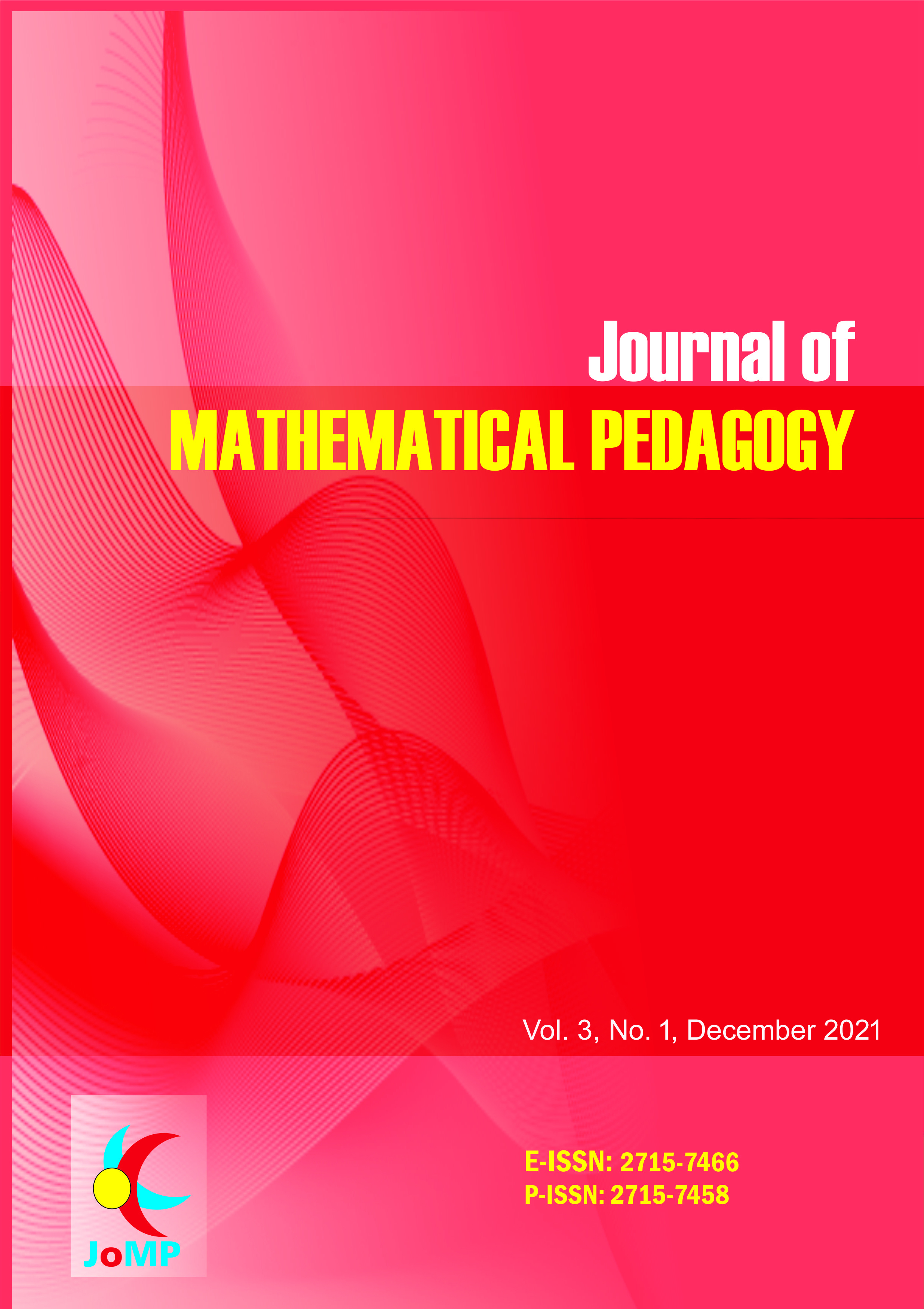Barriers and Strategies to Increase Story as an Instructional Strategy
DOI:
https://doi.org/10.26740/jomp.v3n1.p12-21Keywords:
Barriers and strategy, Story as an instructional strategy, Mathematics learningAbstract
Story is an instructional strategy that is often forgotten or misused. Some mathematics educators believe they are using story when in reality only utilizing word problems, which is very different from story as an instructional strategy. When used properly, story gets students emotionally invested within the story and their learning, this increases student achievement in mathematics. Despite the low scores on the Florida State Assessment (FSA) Algebra 1 End-of-Course (EOC), teachers are still not using story as an instructional strategy. This study determines the barriers preventing the usage, along with strategies to increase the usage of story as an instructional strategy.
References
Allen, M. (2017). Survey: Open-ended questions. The SAGE Encyclopedia of Communication Research Methods. SAGE Link. https://doi.org/10.4135/9781483381411.n608
Bradt, K. M. (1997). Story as a way of knowing. Kansas City, MO: Sheed & Ward.
Branigan, E. (1992). Narrative comprehension and film. Routledge.
Bruner, J. (1990). Acts of meaning. Cambridge, MA: Harvard University Press.
Burns, B., Henry, J., McCarthy, D., & Tripp, J. (2017, October). The value of the math circle for gifted middle school students. Gifted Child Today, 40(4), 198-204. doi:10.1177/1076217517723677
Creswell, J. W. (2013). Qualitative inquiry and research design: Choosing among five approaches (3rd ed.). Sage Publications.
Creswell, J. W., & Plano Clark, V. L. (2007). Designing and conducting mixed methods research. Sage Publications
Devlin, K. (2000). The four faces of mathematics. In M. J. Burke & F. R. Curcio (Eds.), Learning Mathematics for a New Century: 2000 Yearbook of the National Council of Teachers of Mathematics (pp. 16-27). Reston, VA: NCTM
Dracup, M. (2012). Designing online role plays with a focus on story development to support engagement and critical learning for higher education students. Journal of Learning Design, 5(2), 12-24.
Edwards, S. (2015, Spring). Active learning in the middle grades classroom: Overcoming the barriers to implementation. Middle Grades Research Journal, 10(1), 65-81.
Egan, K. (1989). Teaching as story telling: An alternate approach to teaching and curriculum in the elementary school. The University of Chicago Press.
Emerson, R. M., Fretz, R. I., & Shaw, L. L. (2011). Writing ethnographic field notes (2nd ed.). University of Chicago Press.
Florida Department of Education. (2020). Florida statewide assessment program. http://www.fldoe.org/accountability/assessments/k-12-studentassessment/results/2018.stml
Glickman, C. D., Gordon, S. P., & Ross-Gordon, J. M. (2015). Supervision and instructional leadership: A developmental approach (9th ed.). Boston, MA: Allyn & Bacon.
Grabmeier, J. (2017, July 12). Study reveals the hidden ways math helps us in everyday life. PLoS ONE. Retrieved from: https://phys.org/news/2017-07-reveals-hidden-ways-math-everyday.html
Groenewald, T. (2004). A phenomenological research design illustrated. International Journal of Qualitative Methods, 3(1), 42-55.
Haven, K. (2007). Story proof: The science behind the startling power of story. Greenwood Publishing.
Haven, K. (2014). Story smart: Using the science story to persuade, influence, inspire, and teach. Library of Congress Cataloging in-Publication Data.
Husserl, E. (2012). Ideas: General introduction to pure phenomenology. Routledge
Johnson, C. C. (2006). Effective professional development and change in practice: Barriers science teachers encounter and implications for reform. School Science and Mathematics, 106, 150-61.
Jones, J. (2018, August 08). The effects of not graduating high school. The Classroom. https://www.theclassroom.com/consequences-dropping-high-school-getting-ged2219.html
Junkin, S. F. (2019). Story as an instructional strategy in secondary mathematics: Barriers that prevent its implementation (Publication No. 13896147) [Doctoral dissertation, Florida Gulf Coast University]. ProQuest Dissertations and Theses Global.
Kaminsky, D. (1996, April). Treating alcoholism through a narrative approach. Canadian Family Physician, 42, 673-676.
Keller, S., & Conradin, K. (2018, November 28). Semi-structured interviews. SSWM. Retrieved from: https://sswm.info/planning-and-programming/decision-making/gathering-ideas/semi-structured-interviews
Kitchen, M. (2016, March 14). Show students the real purpose of math. Mathematics teaching in the middle school. Retrieved from https://www.nctm.org/Publications/Mathematics-Teaching-in-Middle-School/Blog/Show-Students-the-Real-Purpose-of-Math/
Klingner, J. K., Ahwee, S., Pilonieta, P., & Menendez, R. (2003, Summer). Barriers and facilitators in scaling up research-based practices. Exceptional Children, 69(4).
Mallan, K. (1997). Storytelling in the school curriculum. Educational Practice & Theory, 19(1), 75-82.
Moore, D. S., McCabe, G. P., & Craig, B. A. (2006). Introduction to the practice of statistics. New York, NY: W. H. Freeman and Company.
Moustakas, C. (1994). Phenomenological research methods. Sage Publications.
Neubauer, B. E., Witkop, C. T., & Varpio, L. (2019). How phenomenology can help us learn from the experiences of others. Perspectives on Medical Education, 8, 90-97.
Nevenglosky, E. A., Cale, C., & Aguilar, S. P. (2019). Barriers to effective curriculum implementation. Research in Higher Education Journal, 36.
Polkinghorne, D. (1988). Narrative knowing and the human sciences. Albany, NY: State University of New York Press.
Richards, J. & Skolits, G. (2009, Fall). Sustaining instructional change: The impact of professional development on teacher adoption of a new instructional strategy. Research in the Schools, 16(2).
Rose, G. (2011). Visual methodologies: An introduction to the interpretation of visual materials. London, UK: Sage.
Rudnick, J. (2014, Sept). Success by numbers: Canada math competitions help prepare students for challenges ahead. Gazette- Ontario Association for Mathematics, 53(1), 22-24.
Schwandt, T. A. (2015). The Sage dictionary of qualitative inquiry (4th ed.). Sage Publications
Szurmak, J., & Thuna, M. (2013). Tell me a story: The use of narrative as a tool for instruction. Educational Media International, 54(1), 546-552.
Tannen, D. (1999). Talking voices: Repetition, dialogue, and imagery conversational discourse. New York, NY: Cambridge University Press.
Tater, M. (1992). Off with their heads: Fairy tales and the culture of childhood. Princeton University Press.
van Manen, M. (1990). Researching lived experience. State University of New York Press.
Woolfolk Hoy, A., & Hoy, W. K. (2021). Instructional leadership: A research-based guide to learning in schools (5th ed.). Boston, MA: Allyn & Bacon.
Wright, C., Diener, M. L., & Kemp, J. L. (2013). Storytelling dramas as a community building activity in an early childhood classroom. Early Childhood Educational Journal, 41(3), 197-210. doi:10.1007/s10643-012-0544-7
 Abstract views: 223
,
Abstract views: 223
, PDF Downloads: 252
PDF Downloads: 252





